Abstract
In anaesthetized cats, sixty-two vagal sensory units with afferent endings in the lower oesophageal sphincter were recorded by means of extracellular glass micro-electrodes implanted in the nodose ganglion. All the receptors had non-medullated fibres, with conduction velocities ranging from 0.8 to 1.2 m/s. From the direct stimulation of the lower oesophageal sphincter, three types of mechanoreceptors were identified. Thirty-one were activated by natural stimuli:tonic contraction of the sphincter and distension elicited by the passage of a bolus. Artificial stimulation effected by digital compression was also effective. These receptors were similar to muscular endings already described in the digestive tract. Their main characteristic, i.e. their slow adaptation, suggests that they act as sensors of sphincter opening and closure. This was corroborated by observations obtained during distension of the cervical or thoracic oesophagus; a maximum decrease occurred in the lower oesophageal sphincter mechanoreceptor discharge when the distension was produced between 9 and 12 cm from the lower oesophageal sphincter. Twenty-nine endings were found in the superficial layers (mucosae). Contrary to the muscular receptors, the mucosal receptors were not affected by normal contractions or distensions of the lower oesophageal sphincter. They were activated only by strong stimuli like digital compression or distension achieved with a balloon. In addition, mucosal stroking was a potent stimulus. Whatever the stimulus used, the mucosal receptors showed rather rapidly adapting discharges. These receptors should be considered to be sensors of bolus consistency. Two mechanoreceptors, located in the serous membrane of the lower oesophageal sphincter, were identified by touching or by stretching. Their discharges showed that they belonged to the rapidly adapting type. A comparison of the three types of receptors found in the lower oesophageal sphincter is made with known digestive endings and their possible role is discussed.
Full text
PDF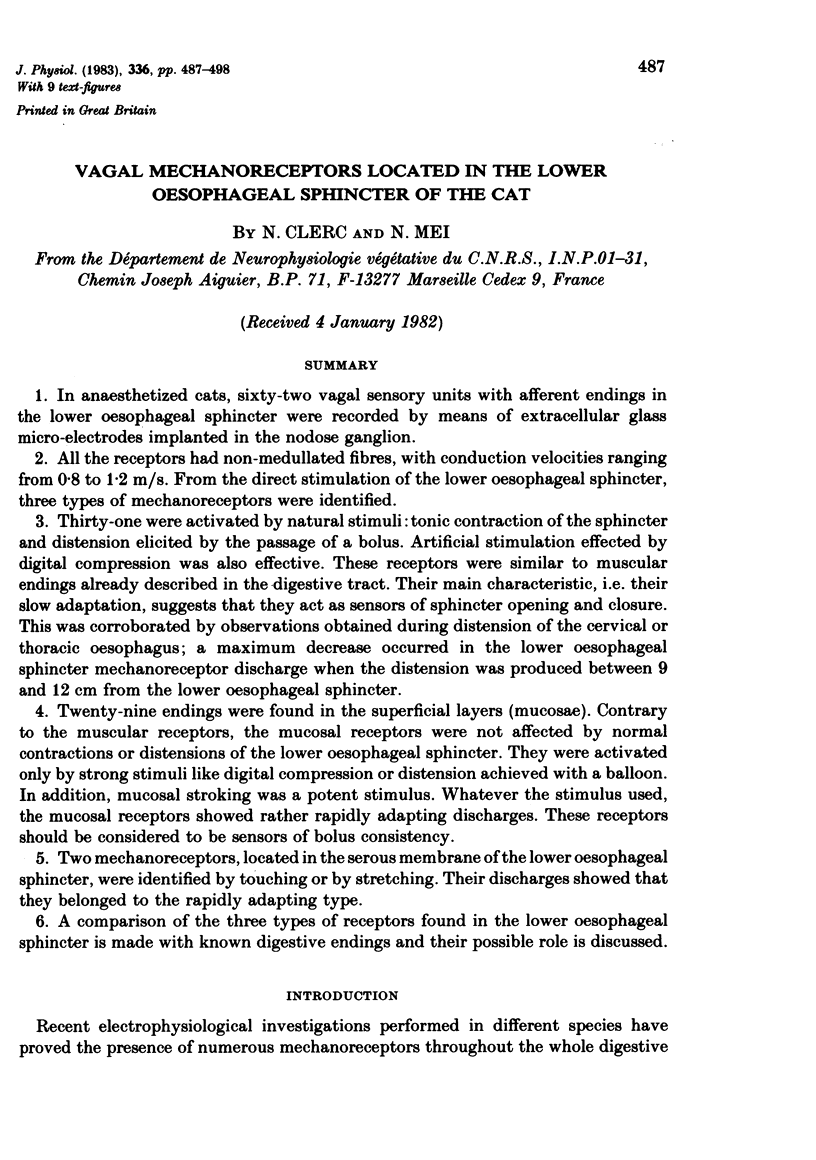
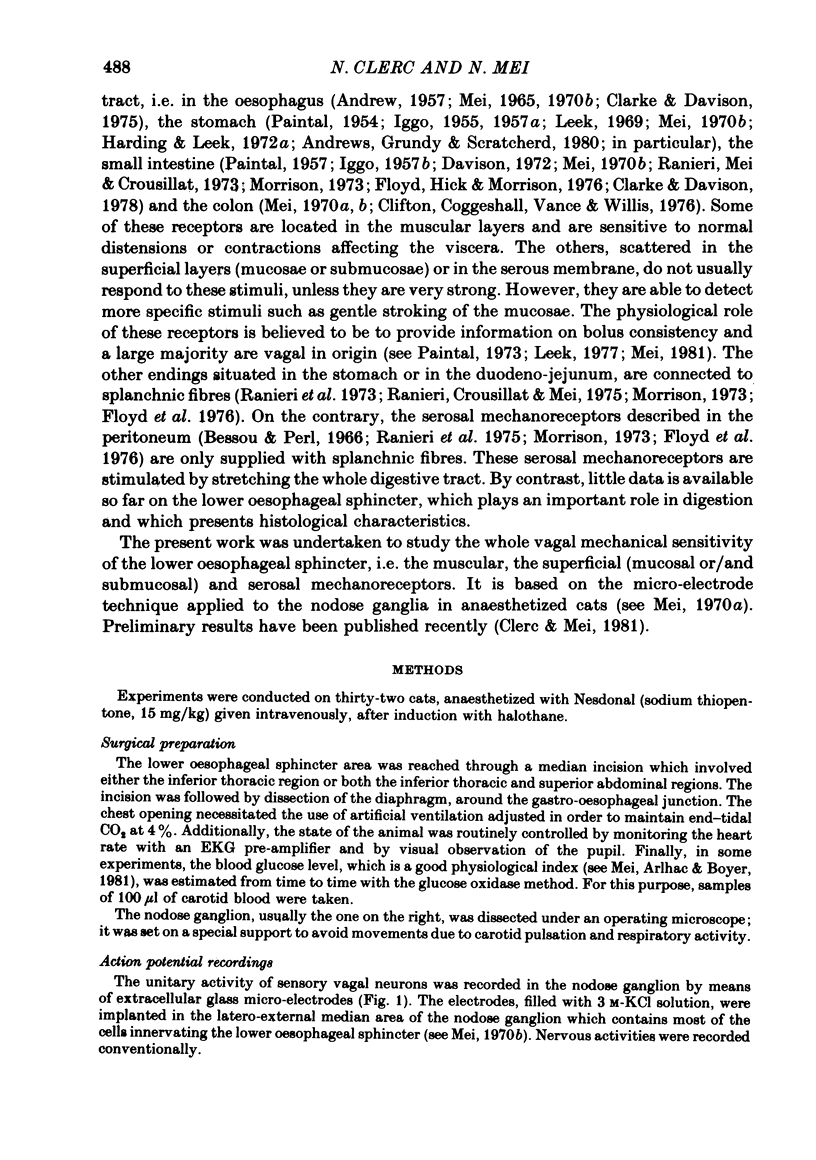
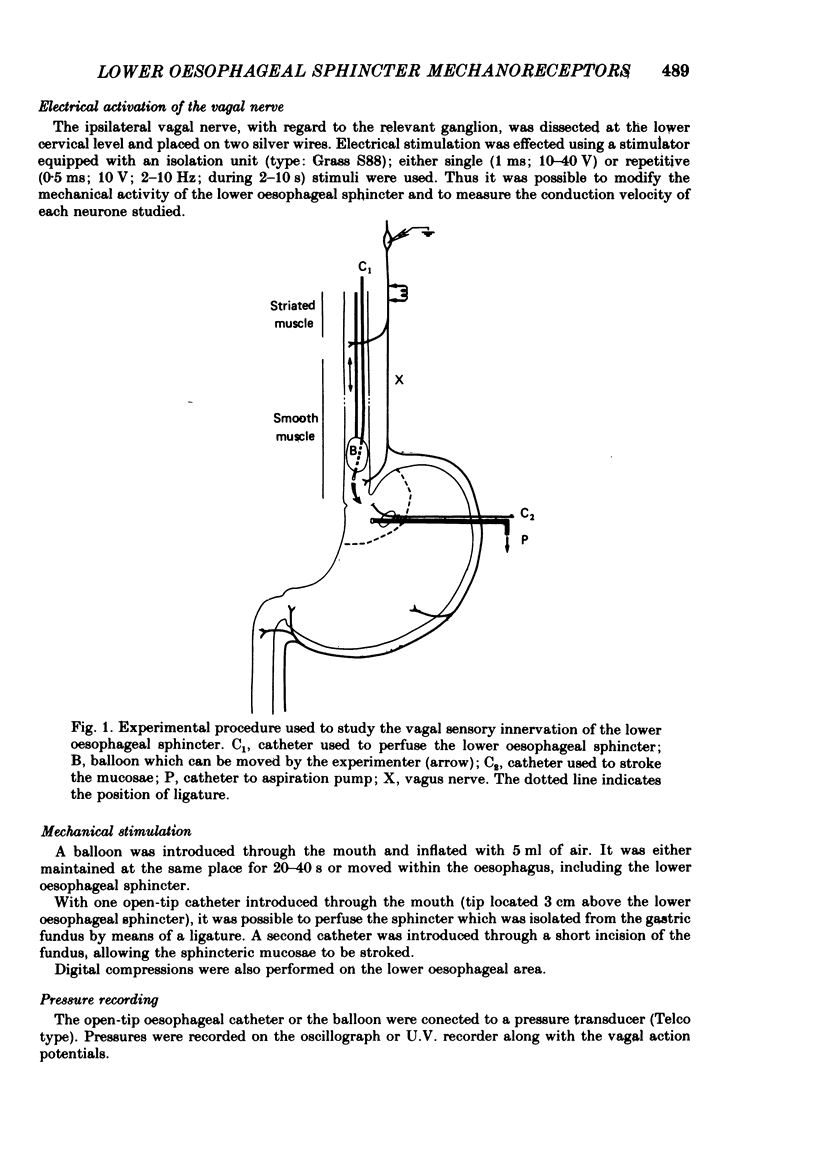
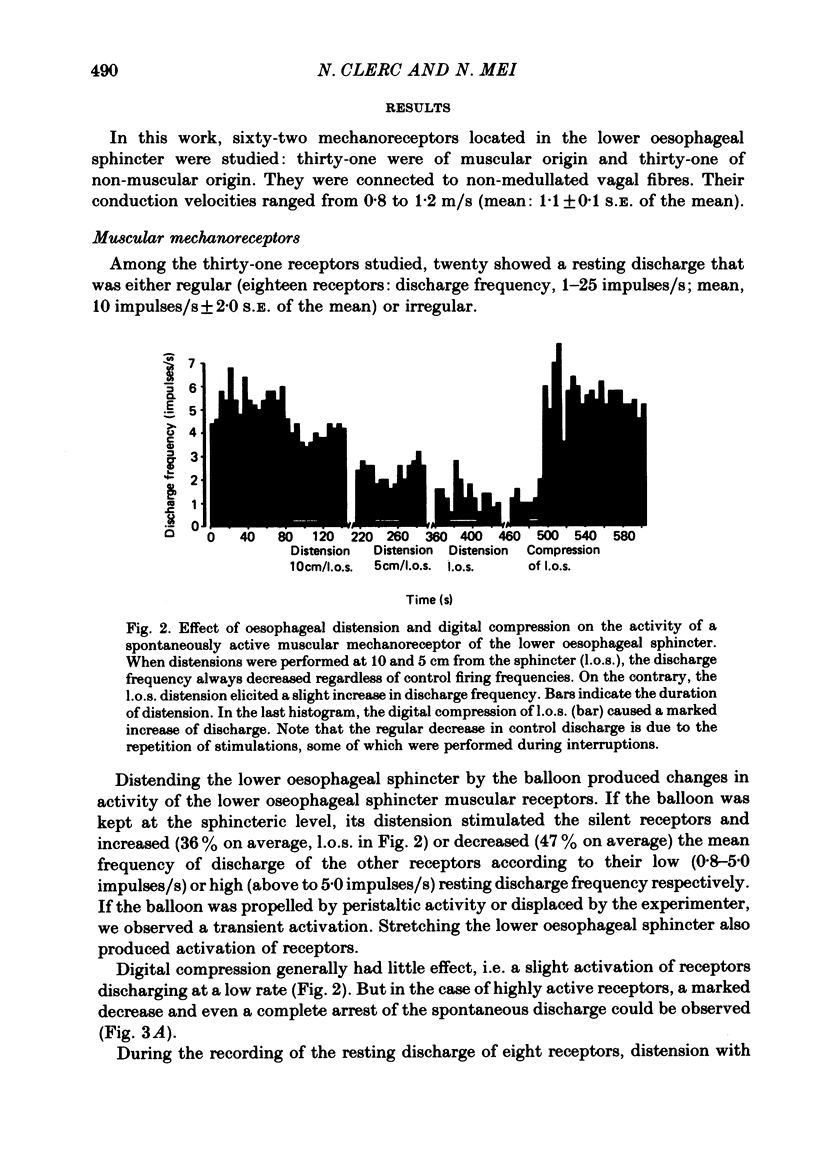

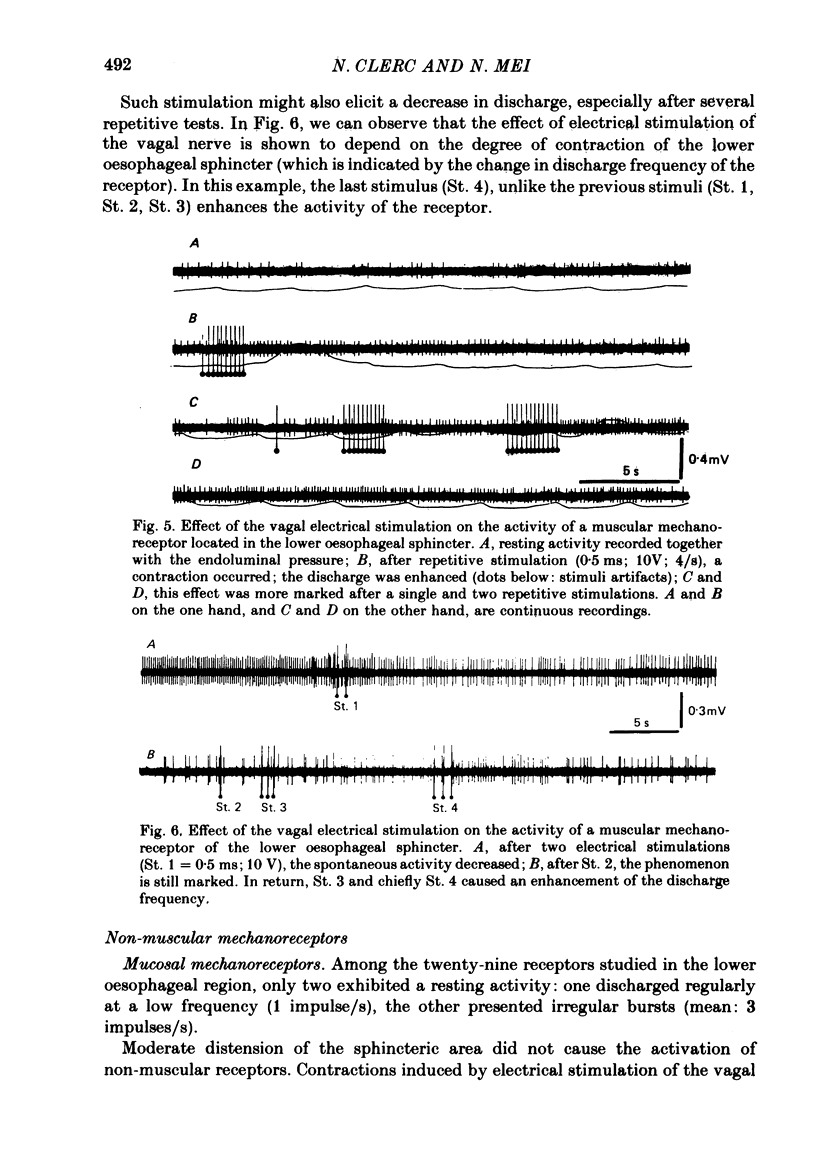
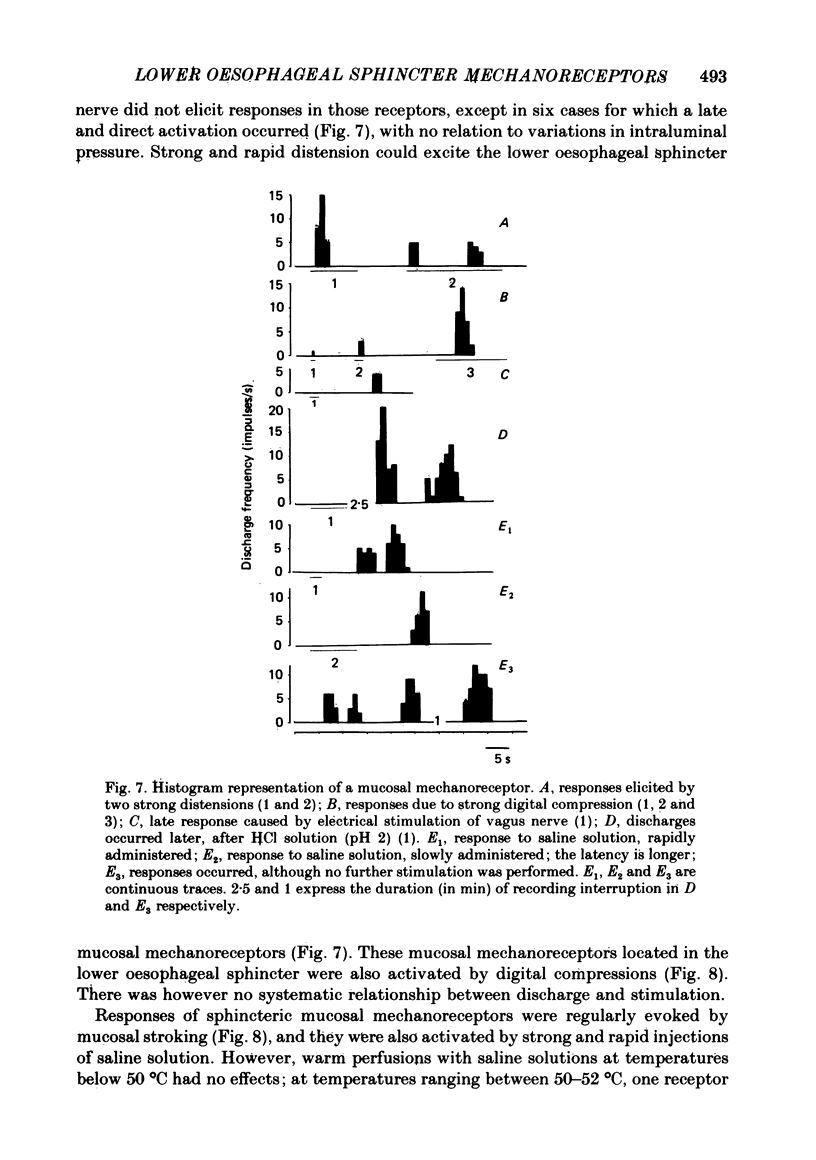
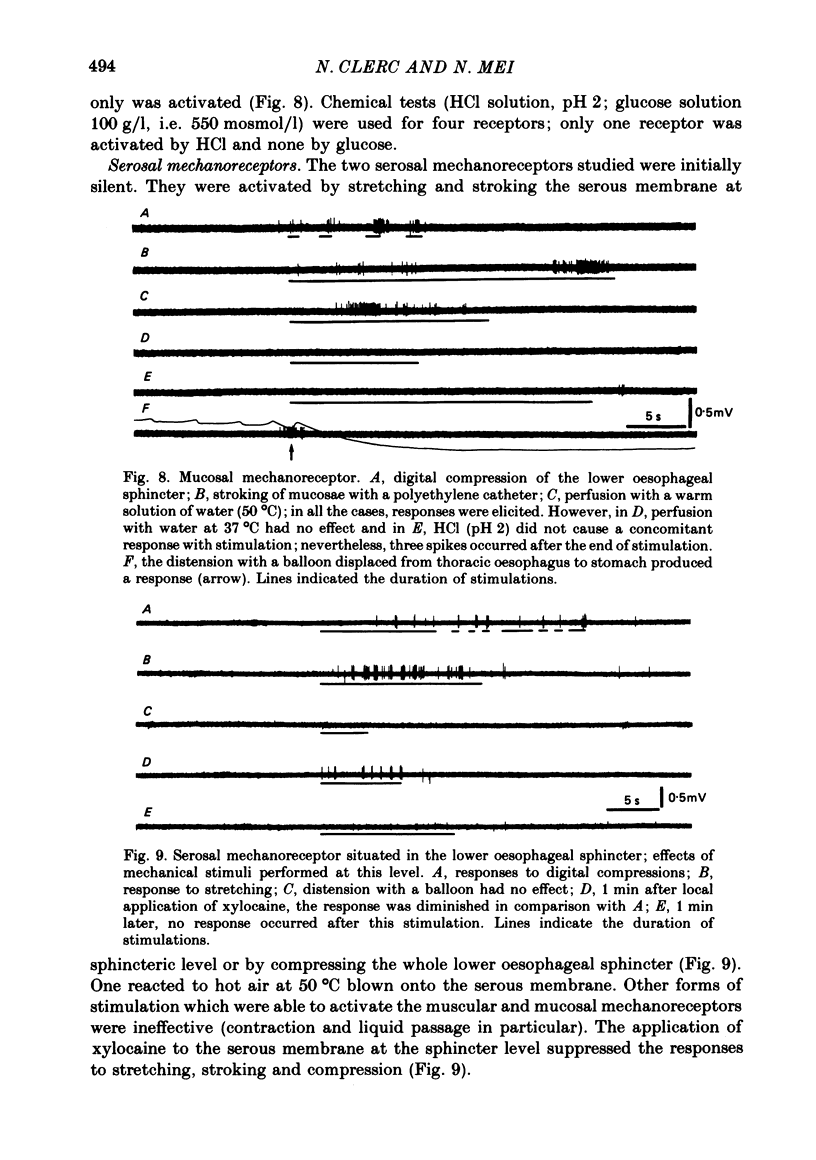
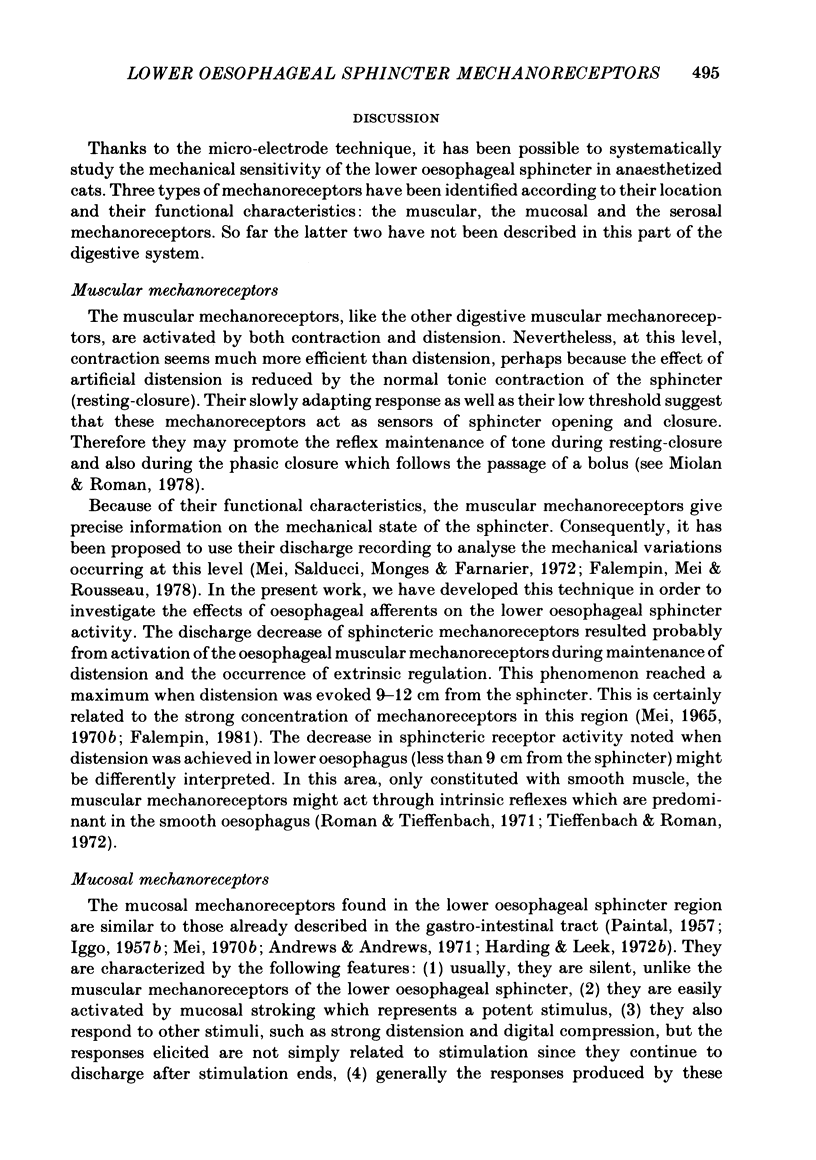
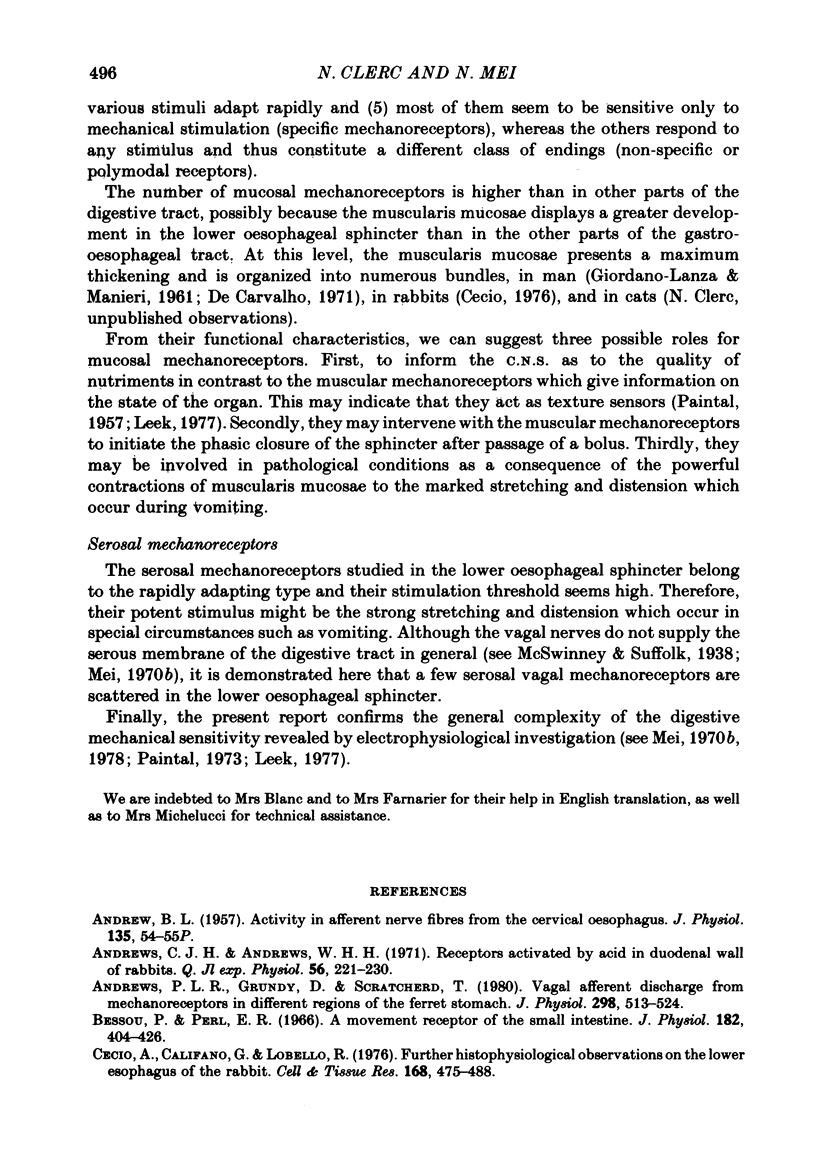
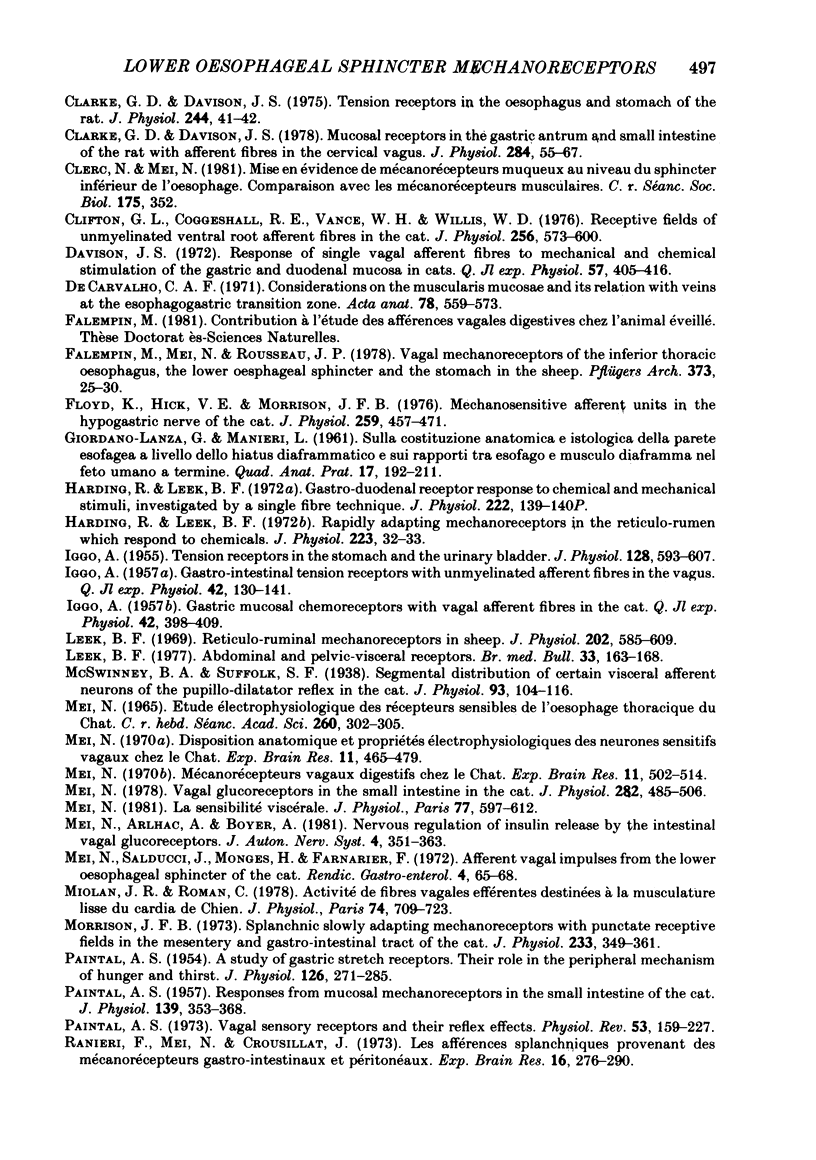
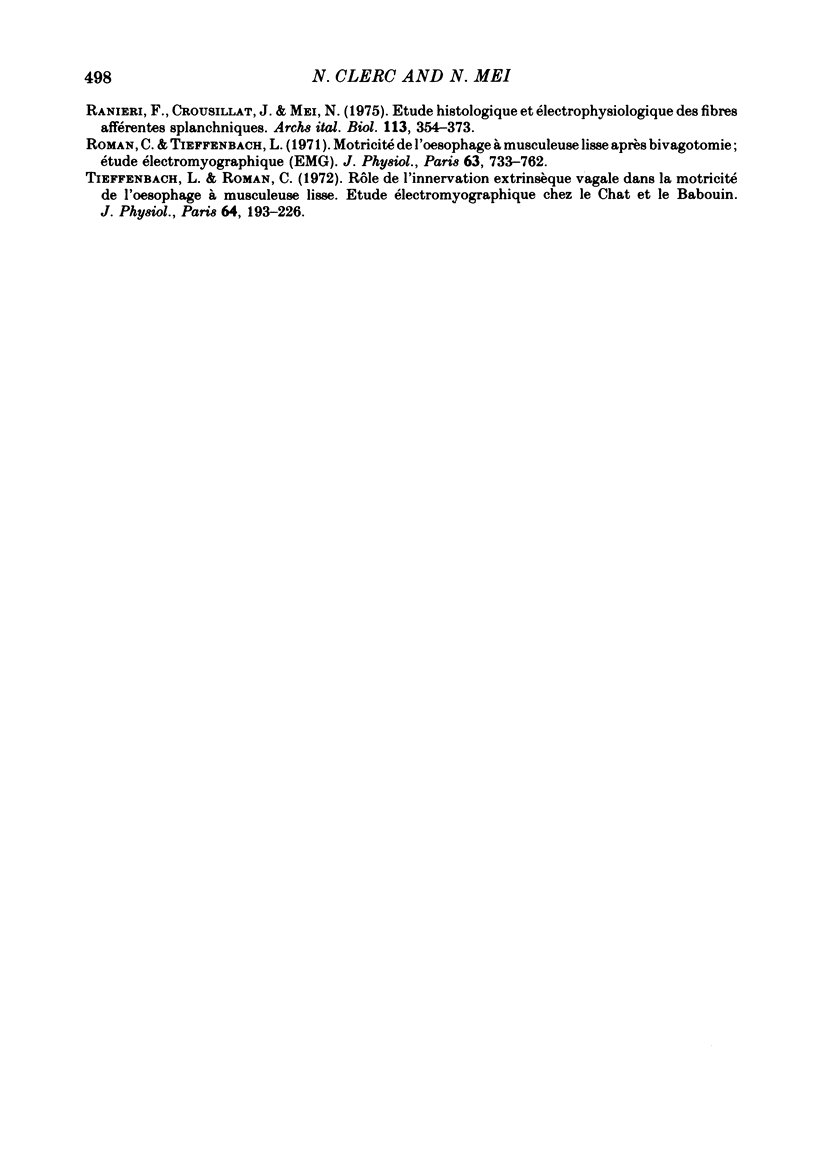
Selected References
These references are in PubMed. This may not be the complete list of references from this article.
- ANDREW B. L. Activity in afferent nerve fibres from the cervical oesophagus. J Physiol. 1957 Feb 15;135(2):54–5P. [PubMed] [Google Scholar]
- Andrews C. J., Andrews W. H. Receptors, activated by acid, in the duodenal wall of rabbits. Q J Exp Physiol Cogn Med Sci. 1971 Oct;56(4):221–230. doi: 10.1113/expphysiol.1971.sp002123. [DOI] [PubMed] [Google Scholar]
- Andrews P. L., Grundy D., Scratcherd T. Vagal afferent discharge from mechanoreceptors in different regions of the ferret stomach. J Physiol. 1980 Jan;298:513–524. doi: 10.1113/jphysiol.1980.sp013098. [DOI] [PMC free article] [PubMed] [Google Scholar]
- Bessou P., Perl E. R. Amovement receptor of the small intestine. J Physiol. 1966 Jan;182(2):404–426. doi: 10.1113/jphysiol.1966.sp007829. [DOI] [PMC free article] [PubMed] [Google Scholar]
- Cecio A. Further histophysiological observations on the lower esophagus of the rabbit. Cell Tissue Res. 1976 May 26;168(4):475–488. doi: 10.1007/BF00215998. [DOI] [PubMed] [Google Scholar]
- Clarke G. D., Davison J. S. Mucosal receptors in the gastric antrum and small intestine of the rat with afferent fibres in the cervical vagus. J Physiol. 1978 Nov;284:55–67. doi: 10.1113/jphysiol.1978.sp012527. [DOI] [PMC free article] [PubMed] [Google Scholar]
- Clerc N., Mei N. Mise en évidence de mécanorécepteurs muqueux au niveau du sphincter inférieur de l'oesophage. Comparaison avec les mécanorécepteurs musculaires. C R Seances Soc Biol Fil. 1981;175(3):352–356. [PubMed] [Google Scholar]
- Clifton G. L., Coggeshall R. E., Vance W. H., Willis W. D. Receptive fields of unmyelinated ventral root afferent fibres in the cat. J Physiol. 1976 Apr;256(3):573–600. doi: 10.1113/jphysiol.1976.sp011340. [DOI] [PMC free article] [PubMed] [Google Scholar]
- Davison J. S. Response of single vagal afferent fibres to mechanical and chemical stimulation of the gastric and duodenal mucosa in cats. Q J Exp Physiol Cogn Med Sci. 1972 Oct;57(4):405–416. doi: 10.1113/expphysiol.1972.sp002176. [DOI] [PubMed] [Google Scholar]
- Falempin M., Mei N., Rousseau J. P. Vagal mechanoreceptors of the inferior thoracic oesophagus, the lower oesophageal sphincter and the stomach in the sheep. Pflugers Arch. 1978 Jan 31;373(1):25–30. doi: 10.1007/BF00581145. [DOI] [PubMed] [Google Scholar]
- Ferraz de Carvalho C. A. Considerations on the muscularis mucosae and its relations with veins at the esophagogastric transition zone. Acta Anat (Basel) 1971;78(4):559–573. doi: 10.1159/000143614. [DOI] [PubMed] [Google Scholar]
- Floyd K., Hick V. E., Morrison J. F. Mechanosensitive afferent units in the hypogastric nerve of the cat. J Physiol. 1976 Jul;259(2):457–471. doi: 10.1113/jphysiol.1976.sp011476. [DOI] [PMC free article] [PubMed] [Google Scholar]
- Harding R., Leek B. F. Gastro-duodenal receptor responses to chemical and mechanical stimuli, investigated by a 'single fibre' technique. J Physiol. 1972 Apr;222(2):139P–140P. [PubMed] [Google Scholar]
- IGGO A. Gastric mucosal chemoreceptors with vagal afferent fibres in the cat. Q J Exp Physiol Cogn Med Sci. 1957 Oct;42(4):398–409. doi: 10.1113/expphysiol.1957.sp001284. [DOI] [PubMed] [Google Scholar]
- IGGO A. Gastro-intestinal tension receptors with unmyelinated afferent fibres in the vagus of the cat. Q J Exp Physiol Cogn Med Sci. 1957 Jan;42(1):130–143. doi: 10.1113/expphysiol.1957.sp001228. [DOI] [PubMed] [Google Scholar]
- IGGO A. Tension receptors in the stomach and the urinary bladder. J Physiol. 1955 Jun 28;128(3):593–607. doi: 10.1113/jphysiol.1955.sp005327. [DOI] [PMC free article] [PubMed] [Google Scholar]
- Leek B. F. Abdominal and pelvic visceral receptors. Br Med Bull. 1977 May;33(2):163–168. doi: 10.1093/oxfordjournals.bmb.a071417. [DOI] [PubMed] [Google Scholar]
- Leek B. F. Reticulo-ruminal mechanoreceptors in sheep. J Physiol. 1969 Jun;202(3):585–609. doi: 10.1113/jphysiol.1969.sp008829. [DOI] [PMC free article] [PubMed] [Google Scholar]
- McSwiney B. A., Suffolk S. F. Segmental distribution of certain visceral afferent neurones of the pupillo-dilator reflex in the cat. J Physiol. 1938 Jul 14;93(2):104–116. doi: 10.1113/jphysiol.1938.sp003629. [DOI] [PMC free article] [PubMed] [Google Scholar]
- Mei N., Arlhac A., Boyer A. Nervous regulation of insulin release by the intestinal vagal glucoreceptors. J Auton Nerv Syst. 1981 Nov;4(4):351–363. doi: 10.1016/0165-1838(81)90038-2. [DOI] [PubMed] [Google Scholar]
- Mei N. Disposition anatomique et propriétés électrophysiologiques des neurones sensitifs vagaux chez le chat. Exp Brain Res. 1970;11(5):465–479. [PubMed] [Google Scholar]
- Mei N. Mécanorécepteurs vagaux digestifs chez le chat. Exp Brain Res. 1970;11(5):502–514. [PubMed] [Google Scholar]
- Mei N. Vagal glucoreceptors in the small intestine of the cat. J Physiol. 1978 Sep;282:485–506. doi: 10.1113/jphysiol.1978.sp012477. [DOI] [PMC free article] [PubMed] [Google Scholar]
- Miolan J. P., Roman C. Activité des fibres vagales efférentes destinées à la musculature lisse du cardia du chien. J Physiol (Paris) 1978;74(8):709–723. [PubMed] [Google Scholar]
- Morrison J. F. Splanchnic slowly adapting mechanoreceptors with punctate receptive fields in the mesentery and gastrointestinal tract of the cat. J Physiol. 1973 Sep;233(2):349–361. doi: 10.1113/jphysiol.1973.sp010311. [DOI] [PMC free article] [PubMed] [Google Scholar]
- PAINTAL A. S. Responses from mucosal mechanoreceptors in the small intestine of the cat. J Physiol. 1957 Dec 31;139(3):353–368. doi: 10.1113/jphysiol.1957.sp005896. [DOI] [PMC free article] [PubMed] [Google Scholar]
- PAINTAL A. S. The response of gastric stretch receptors and certain other abdominal and thoracic vagal receptors to some drugs. J Physiol. 1954 Nov 29;126(2):271–285. doi: 10.1113/jphysiol.1954.sp005208. [DOI] [PMC free article] [PubMed] [Google Scholar]
- Paintal A. S. Vagal sensory receptors and their reflex effects. Physiol Rev. 1973 Jan;53(1):159–227. doi: 10.1152/physrev.1973.53.1.159. [DOI] [PubMed] [Google Scholar]
- Ranieri F., Crousillat J., Mei N. Etude électrophysiologique et histologique des fibres afférentes splanchniques. Arch Ital Biol. 1975 Dec;113(4):354–373. [PubMed] [Google Scholar]
- Ranieri F., Mei N., Crousillat J. Les afférences splanchniques provenant des mécanorécepteurs gastro-intestinaux et péritonéaux. Exp Brain Res. 1973 Jan 29;16(3):276–290. doi: 10.1007/BF00233331. [DOI] [PubMed] [Google Scholar]
- Roman C., Tieffenbach L. Motricité de l'oesophage à musculeuse lisse après bivagotomie. Etude électromyographique (E.M.G. J Physiol (Paris) 1971;63(8):733–762. [PubMed] [Google Scholar]
- Tieffenbach L., Roman C. Rle de l'innervation extrinsèque vagale dans la motricité de l'oesophage à musculeuse lisse: Etude électromyographique chez le chat et le babouin. J Physiol (Paris) 1972;64(3):193–226. [PubMed] [Google Scholar]


